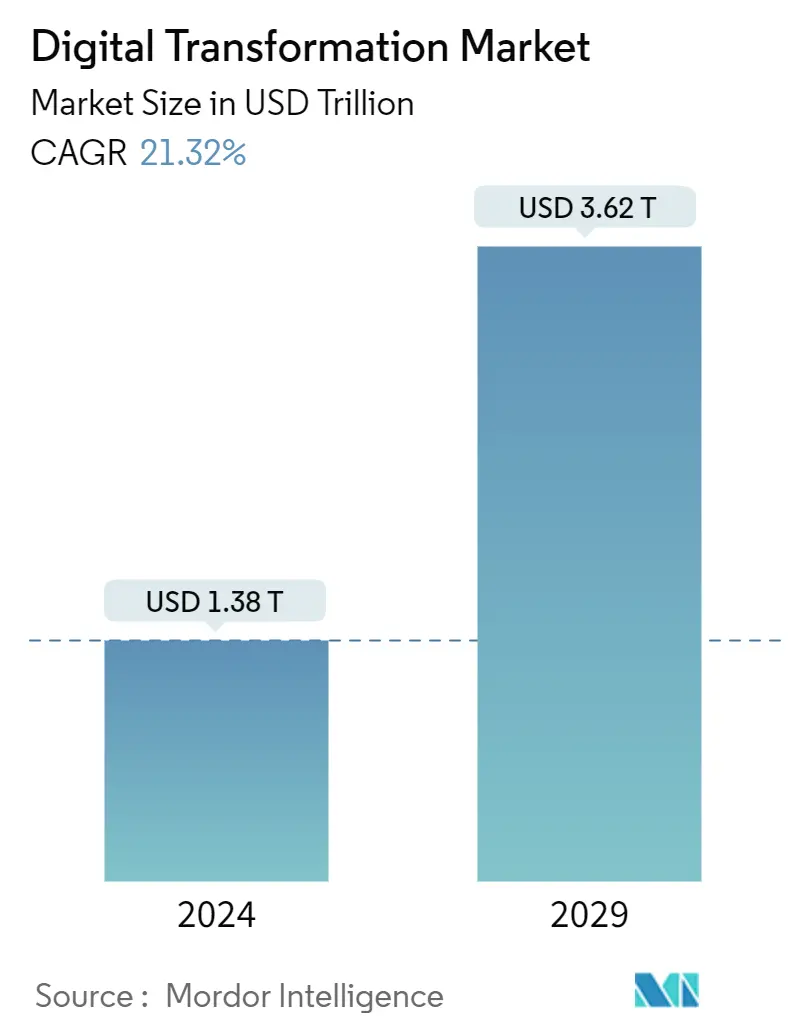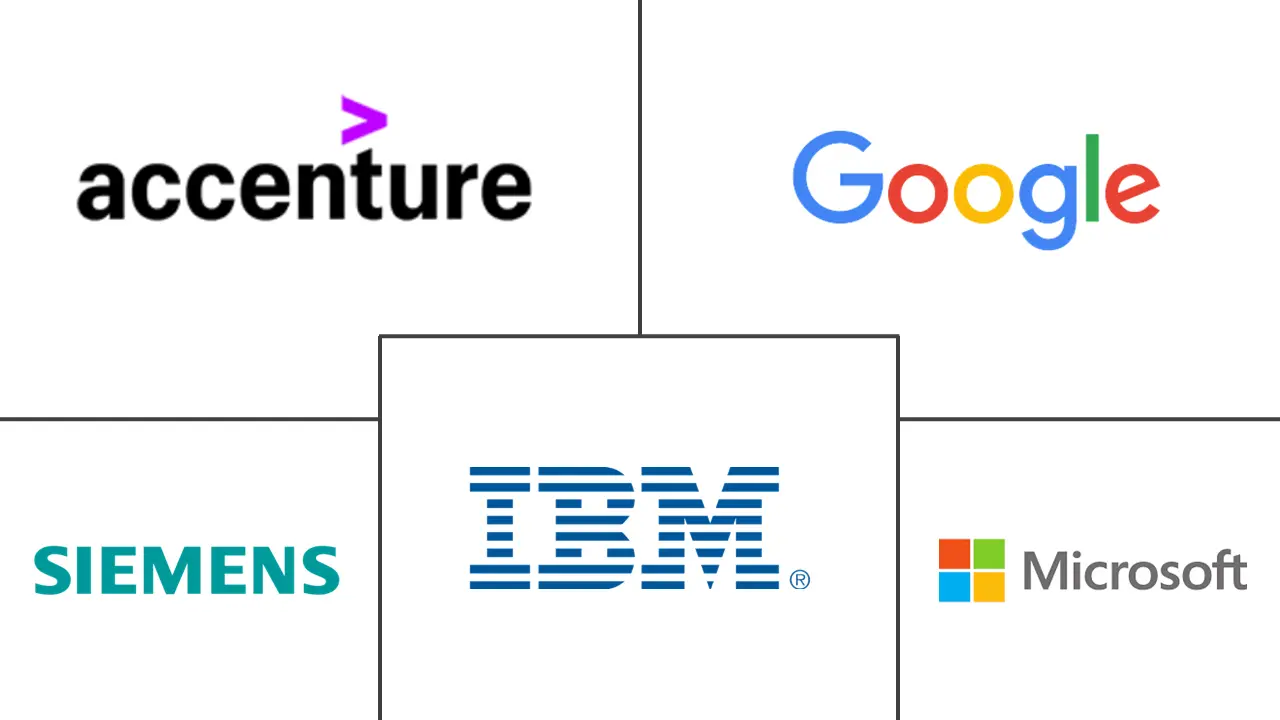Market Size of Digital Transformation Industry

| Study Period | 2019 - 2029 |
| Market Size (2024) | USD 1.38 Trillion |
| Market Size (2029) | USD 3.62 Trillion |
| CAGR (2024 - 2029) | 21.32 % |
| Fastest Growing Market | Asia-Pacific |
| Largest Market | Asia-Pacific |
Major Players
*Disclaimer: Major Players sorted in no particular order |
Digital Transformation Market Analysis
The Digital Transformation Market size is estimated at USD 1.38 trillion in 2024, and is expected to reach USD 3.62 trillion by 2029, growing at a CAGR of 21.32% during the forecast period (2024-2029).
- With the introduction of Industry 4.0 in the manufacturing sector, numerous factories are embracing digital technology to improve, automate, and upgrade the whole process. Industry 4.0 technology, such as robotization, is already commonplace in many enterprises. For example, Vepa, a project and office furniture maker, employs robotization in its warehouse to help it increase its turnover. Collaborative robots are projected to see a growing application in production.
- According to IFR, the industry for collaborative robots is anticipated to reach USD 12.3 billion by 2025. Intelligent robots work alongside humans and can be trained by most production workers to execute the most common, time-consuming jobs and deliver them properly.
- Furthermore, the increasing use of IoT devices in companies is predicted to accelerate digital transformation in various industries. According to Cisco's Annual Internet Report, there will be about 30 billion network-connected gadgets and services by 2023. IoT devices will account for 50% (14.7 billion) of all networked devices by 2023.
- As AI and deep learning applications expand globally, from tech giants to small and medium-sized businesses, there has been a shortage of expert AI technicians. Without talent, these increased investments in artificial intelligence and machine learning could be wasted, leading to financial losses and unrealized opportunities.
- Remote workers used system solutions to manage various activities. It incorporates various sophisticated technologies, such as artificial intelligence (AI), cloud computing, products, big data tools, and capabilities, to maximize company operations. Following the pandemic, some firms intend to invest in modern technology to address the increasing need for digitalization. For instance, in January 2022, Google, an Alphabet LLC company, committed around USD 1 billion in collaboration with Airtel. The collaboration aimed to provide companies with cheaper smartphone access while also increasing their use of cloud-based computing. The investment aided in the digitization of India's small enterprises by allowing them to use digital technologies. Such initiatives are projected to boost the demand for digital transformation and help the market grow post-COVID-19.
Digital Transformation Industry Segmentation
Digital transformation is the process of incorporating digital technologies such as artificial intelligence and machine learning, extended reality (VR & AR) for industrial applications, IoT, industrial robotics, blockchain, digital twin, 3D printing/ additive manufacturing, industrial cyber security, wireless connectivity, edge computing, smart mobility, and other technologies across various end-user industry.
The digital transformation market is segmented by type (artificial intelligence and machine learning, extended reality (VR & AR) for industrial applications, IoT, industrial robotics, blockchain, digital twin, additive manufacturing, industrial cyber security, wireless connectivity, industrial 3d printing market, edge computing, smart mobility) and by geography (North America, Europe, Asia-Pacific, Latin America, Middle East and Africa). The market sizes and forecasts are provided in terms of value in USD for all the above segments.
| By Type | |||||||||||||||
| |||||||||||||||
| |||||||||||||||
| |||||||||||||||
| |||||||||||||||
| |||||||||||||||
| |||||||||||||||
| |||||||||||||||
| |||||||||||||||
| |||||||||||||||
| |||||||||||||||
| |||||||||||||||
|
| By Geography*** | |
| North America | |
| Europe | |
| Asia-Pacific | |
| Latin America | |
| Middle East and Africa |
Digital Transformation Market Size Summary
The digital transformation market is experiencing significant growth, driven by the adoption of advanced technologies such as Industry 4.0, IoT, and AI across various sectors. The manufacturing industry, in particular, is undergoing a substantial shift towards smart factory automation, where IoT and robotics are enhancing efficiency and reducing downtime. This transformation is not limited to manufacturing; sectors like automotive and healthcare are also embracing these technologies to streamline operations and improve productivity. The increasing integration of IoT devices and systems is facilitating intelligent connectivity, which is pivotal in the next industrial revolution. As companies invest in digital technologies to meet the demands of a post-pandemic world, the market is poised for robust expansion.
China's strategic initiatives, such as the "Made in China 2025" program, are significantly influencing the global digital transformation landscape. The country's focus on high-end industrial production and smart manufacturing is expected to capture a substantial share of the industrial IoT market. This shift is supported by government policies promoting robotics, AI, and IoT, which are integral to China's vision for economic and social development. The digital transformation market is semi-consolidated, with major players like Accenture, Google, Siemens, IBM, and Microsoft leading the charge through strategic partnerships and innovations. These companies are enhancing their offerings to gain a competitive edge, as evidenced by recent collaborations and acquisitions aimed at optimizing cloud services and advancing digital solutions.
Digital Transformation Market Size - Table of Contents
-
1. MARKET SEGMENTATION
-
1.1 By Type
-
1.1.1 Artificial Intelligence and Machine Learning
-
1.1.1.1 Current Market Scenario and Market Projections for the Forecast Period
-
1.1.1.2 Key Growth Influencers (Drivers, Challenges, and Opportunities)
-
1.1.1.3 Market Breakdown by Type (Demand Forecasts | Trends | Market Outlook)
-
1.1.1.3.1 Machine Learning
-
1.1.1.3.2 Natural Language Processing (NLP)
-
1.1.1.3.3 Context-aware Computing
-
1.1.1.3.4 Computer Vision
-
1.1.1.3.5 Other Types
-
-
1.1.1.4 Market Breakdown by End-user (Manufacturing, Oil and Gas, Utilities, Automotive and Transportation, Retail, BFSI, Process Industries, and Others)
-
1.1.1.5 Market Breakdown by Region (North America, Europe, Asia-Pacific, and Rest of the World)
-
1.1.1.6 Analysis of the Key Market Incumbents and Emerging Players
-
1.1.1.7 Market Outlook
-
-
1.1.2 Extended Reality (VR & AR) for Industrial Applications
-
1.1.2.1 Current Market Scenario and Market Projections for the Forecast Period
-
1.1.2.2 Key Growth Influencers (Drivers, Challenges, and Opportunities)
-
1.1.2.3 Market Breakdown by Use-cases (Training & Simulation, Production & Assembly, 3D Modeling, Sales & Marketing, and Others)
-
1.1.2.4 Relative Growth Forecast Analysis for VR & AR
-
1.1.2.5 Market Breakdown by Region (North America, Europe, Asia-Pacific, and Rest of the World)
-
1.1.2.6 Analysis of the Key Market Incumbents and Emerging Players
-
1.1.2.7 Market Outlook
-
-
1.1.3 IoT
-
1.1.3.1 Current Market Scenario and Market Projections for the Forecast Period
-
1.1.3.2 Key Growth Influencers (Drivers, Challenges, and Opportunities)
-
1.1.3.3 Market Breakdown by Type (Solutions, Platforms & Services)
-
1.1.3.4 Market Breakdown by Use-case (Predictive Maintenance, Business Process Optimization, Asset Tracking & Supply Chain Management, and Others)
-
1.1.3.5 Market Breakdown by End User (Automotive, Process Industries, Oil & Gas, Automotive & Aerospace, Manufacturing, and Others)
-
1.1.3.6 Market Breakdown by Region
-
1.1.3.7 Analysis of the Key Market Incumbents and Emerging Players
-
1.1.3.8 Market Outlook
-
-
1.1.4 Industrial Robotics
-
1.1.4.1 Current Market Scenario and Market Projections for the Forecast Period
-
1.1.4.2 Key Growth Influencers (Drivers, Challenges, and Opportunities)
-
1.1.4.3 Market Breakdown by Type (Articulated, Linear, Cylindrical, Parallel, SCARA, and Others)
-
1.1.4.4 Market Breakdown by End User (Metal & Machinery, Electrical & Electronics, Automotive, Chemical and Manufacturing, and Others)
-
1.1.4.5 Market Breakdown by Region
-
1.1.4.6 Analysis of the Key Market Incumbents and Emerging Players
-
1.1.4.7 Market Outlook
-
-
1.1.5 Blockchain
-
1.1.5.1 Current Market Scenario and Market Projections for the Forecast Period
-
1.1.5.2 Key Growth Influencers (Drivers, Challenges, and Opportunities)
-
1.1.5.3 Market Breakdown by Type (Logistics & Supply Chain, Counterfeit Management, Quality Control & Compliance, and Others)
-
1.1.5.4 Market Breakdown by Use-case (Automotive, Aerospace & Defense, Industrial, Retail and Others)
-
1.1.5.5 Market Breakdown by Region
-
1.1.5.6 Analysis of the Key Market Incumbents and Emerging Players
-
1.1.5.7 Market Outlook
-
-
1.1.6 Digital Twin
-
1.1.6.1 Current Market Scenario and Market Projections for the Forecast Period
-
1.1.6.2 Key Growth Influencers (Drivers, Challenges, and Opportunities)
-
1.1.6.3 Market Breakdown by Type (Manufacturing. Energy & Power, Aerospace, Oil & Gas, Others)
-
1.1.6.4 Market Breakdown by Region
-
1.1.6.5 Analysis of the Key Market Incumbents and Emerging Players
-
1.1.6.6 Market Outlook
-
-
1.1.7 Additive Manufacturing
-
1.1.7.1 Current Market Scenario and Market Projections for the Forecast Period
-
1.1.7.2 Key Growth Influencers (Drivers, Challenges, and Opportunities)
-
1.1.7.3 Market Breakdown by Type (Equipment, Materials, Services & Software)
-
1.1.7.4 Market Breakdown by End User (Automotive, Manufacturing, Healthcare, Others)
-
1.1.7.5 Market Breakdown by Region
-
1.1.7.6 Analysis of the Key Market Incumbents and Emerging Players
-
1.1.7.7 Market Outlook
-
-
1.1.8 Industrial Cyber security
-
1.1.8.1 Current Market Scenario and Market Projections for the Forecast Period
-
1.1.8.2 Key Growth Influencers (Drivers, Challenges, and Opportunities)
-
1.1.8.3 Market Breakdown by Type (Network, Application, Endpoint, Cloud, Others)
-
1.1.8.4 Market Breakdown by End User (Power, Utilities, Transportation, Chemicals & Manufacturing)
-
1.1.8.5 Market Breakdown by Region
-
1.1.8.6 Analysis of the Key Market Incumbents and Emerging Players
-
1.1.8.7 Market Outlook
-
-
1.1.9 Wireless Connectivity
-
1.1.9.1 Current Market Scenario and Market Projections for the Forecast Period
-
1.1.9.2 Key Growth Influencers (Drivers, Challenges, and Opportunities)
-
1.1.9.3 Market Breakdown by Type (Wi-Fi, NFC, ZigBee, Z-Wave, LTE Cat-M1, NB-IoT, Sigfox, Others)
-
1.1.9.4 Market Breakdown by End User (Automotive & Transportation, Industrial, Telecommunication, Healthcare, Others)
-
-
1.1.10 Industrial 3D Printing Market
-
1.1.10.1 Current Market Scenario and Market Projections for the Forecast Period
-
1.1.10.2 Key Growth Influencers (Drivers, Challenges, and Opportunities)
-
1.1.10.3 Breakdown by Machine & Services
-
-
1.1.11 Edge Computing
-
1.1.11.1 Current Market Scenario and Market Projections for the Forecast Period
-
1.1.11.2 Key Growth Influencers (Drivers, Challenges, and Opportunities)
-
1.1.11.3 Market Breakdown by Hardware, Platforms, Software & Services
-
1.1.11.4 Market Breakdown by End User
-
-
1.1.12 Smart Mobility
-
1.1.12.1 Current Market Scenario and Market Projections for the Forecast Period
-
1.1.12.2 Key Growth Influencers (Drivers, Challenges, and Opportunities)
-
1.1.12.3 Market Breakdown by Type (Traffic Management, Smart Ticketing, Mobility Ridesharing, Ride Hailing, Mobility-as-a-Service, and Smart Highway)
-
1.1.12.4 Smart Materials
-
1.1.12.5 Intelligent Process Automation
-
-
-
1.2 By Geography***
-
1.2.1 North America
-
1.2.2 Europe
-
1.2.3 Asia-Pacific
-
1.2.4 Latin America
-
1.2.5 Middle East and Africa
-
-
Digital Transformation Market Size FAQs
How big is the Digital Transformation Market?
The Digital Transformation Market size is expected to reach USD 1.38 trillion in 2024 and grow at a CAGR of 21.32% to reach USD 3.62 trillion by 2029.
What is the current Digital Transformation Market size?
In 2024, the Digital Transformation Market size is expected to reach USD 1.38 trillion.

